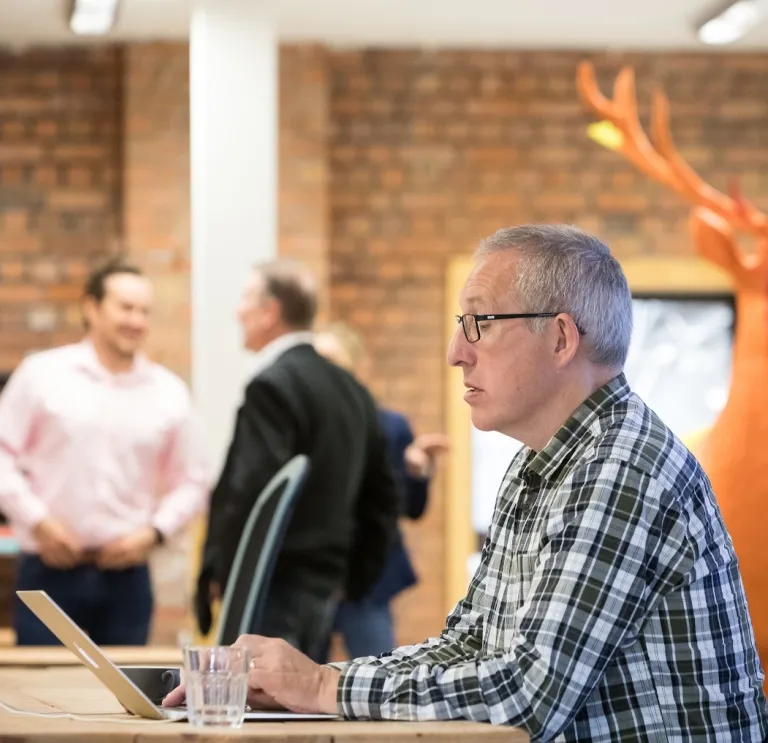But when companies are seeking a home in Wales, it sometimes makes sense to look to the past as well as the future. Buildings such as warehouses, park lodges and chapels have been granted a new lease of life as offices and workshops. And when the Welsh Government provides assistance in finding a new business address, it will always look at all the options, from a new-build to existing property that can be repurposed.
For artificial intelligence company Automise, home is a former tramshed right in the centre of Cardiff. The 30,000sq ft building is split between Tramshed Tech, which provides workspace for Automise and a range of other businesses in the hi-tech and creative sectors, and an arts centre that’s run separately.
The company employs eight people in three handsome offices, surrounded by a score of other sparky, like-minded enterprises. It has no plans to move on from the brick-and-steel Victorian building where the city’s trams were once garaged and maintained.
“A century ago, Cardiff was the fastest-growing city in the world and the tramshed was a centre of high-tech activity,” says Tramshed Tech co-founder Mark John. “Now Cardiff is booming again and Tramshed Tech is a centre for hi-tech excellence once more. We’ve recently set up a networking organisation for AI companies, AI Wales, and five of the founder members are based here.”
The redevelopment has been careful to maintain the feel of a working industrial space, while adding “softer” touches such as custom-designed furniture and fittings and seats recovered from old churches and cinemas. “It has a unique character and flavour,” says John. “Everyone says, ‘Wow! What a lovely space.’”
The idea came about when he and his business partner Louise Harris were looking for new premises for their training business, Big Learning Company. Although renovating an empty shell was challenging, it gave them a blank canvas to create what they wanted. About 140 people work at Tramshed Tech, which is geared to individuals and small, growing businesses, with a mix of offices, hot-desk areas and co-working spaces.
“The exciting thing is getting these companies together and seeing them spark off one another,” says John. “Our tenants love the fact that it’s a real building with real substance and real history, in the heart of a real and diverse community. The artificial-intelligence company Amplyfi looked all over the world for offices – San Francisco, Singapore, Tokyo, Berlin, Vancouver – but they wanted to come to Tramshed.”
Redevelopment can be vital in preserving old buildings and revitalising the communities in which they sit. Galeri Caernarfon is a town development trust that owns and manages more than 20 business and residential properties in Caernarfon, North Wales.
Marketing director Steffan Thomas says: “Most of our properties were bought during the 1990s, when the town was in need of investment. We’d bid for buildings and invest in renovating them and bringing them back to life. As a social enterprise, we’ve always tried to keep rents as low as possible, so we offer affordable units within Caernarfon for companies to base themselves within their community.”
Their tenants are a varied group, encompassing both service and retail. They include an insurance company and a building society, charitable organisations, a photographic studio, a firm of solicitors and even a high-end chocolatier.
Down in Pembroke, West Wales, architect Peter Holden has spent almost three decades renovating old buildings, ranging from workshops to chapels. “We have to be clever in finding new ways to use these old buildings or they’ll simply fall down,” he says.
Holden stresses that what he does is conservation, not restoration to the building’s original form and use: nobody wants to work in a building that’s damp and lit with candles. He says: “We shouldn’t be afraid of adapting these old buildings to new uses. But it has to be done sympathetically and take account of the building’s historic aspects.”
Practising what he preaches, Holden has based his own architectural practice, Acanthus Holden, in a converted 19th-century coffin-maker’s workshop overlooking the castle mill pond in Pembroke. “Obviously it helps our business as conservation architects,” he says. “We use it as an example of joinery and pointing, and I can say, ‘I know under-floor heating works because I’ve put it in my own building.’
“It’s also a joy to work here. We look out onto the Great Keep of Pembroke Castle and the mill pond with kingfishers, otters and little dippers. Having a brilliant office to work out of is a big factor in staff retention. Our staff turnover is very low.”




